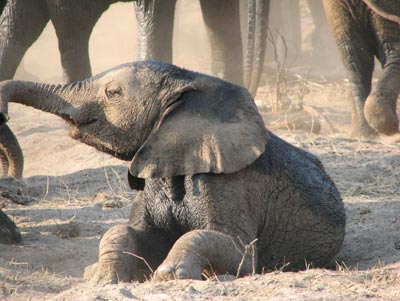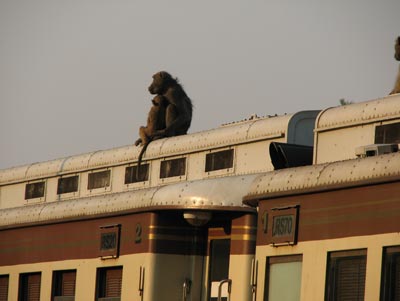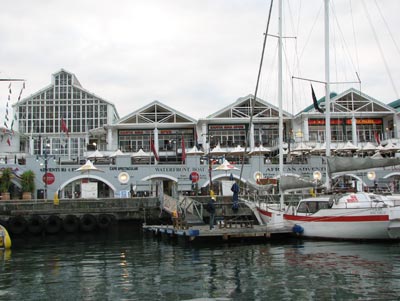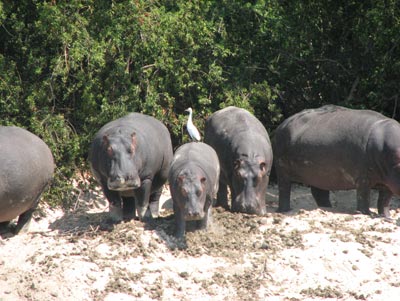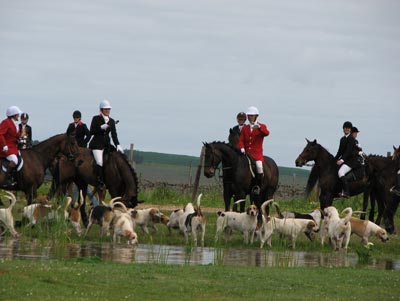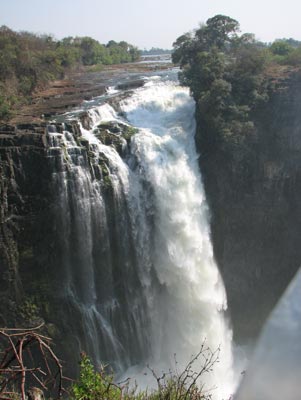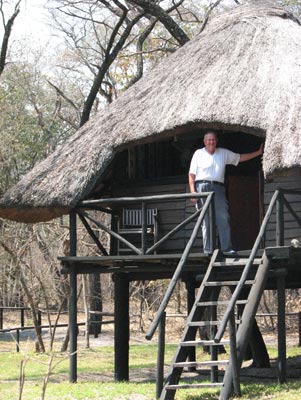A trip of a lifetime with Shongololo Express
by Fritz Oelrich, Stafford, VA
For years I’ve been reading about the trains of South Africa — The Blue Train and those of Rovos Rail and Shongololo Express — with great interest. If you’re not worried about cost, take The Blue Train. If you want to wear a coat and tie to dinner, use Rovos Rail. But if you want a bargain, go with Shongololo Express.
In May ’06, I saw an ad in ITN from Wild African Ventures (Shadow Hills, CA; 800/358-8530, www.wildafricanventures.com) featuring Shongololo Express trains. I contacted Deborah Urquhart and she sent lots of information. (You can also go to www.shongololo.com and get good information and a video).
Deb is from Durban and knows Southern Africa very well. I listened to her advice and the advice of others who had ridden Shongololo Express trains, and my wife, Zelda, and I selected the “Southern Cross Adventure,” with a cabin in Ivory Class, departing in early September ’07. The itinerary included six countries — seven if you count the shore of Namibia — and was a balance of game drives and visits to great sites such as Victoria Falls and Great Zimbabwe.
Making arrangements
Southern Cross, a vintage train of British manufacture, offered cars with bathrooms in the compartments (Gold Class), cars with bathrooms and air-conditioning (Emerald Class) and cars with shared bathrooms (Ivory Class). Due to the condition of the rails, the old train was more than adequate. A newer one wouldn’t have been able to go any faster and would not have been designed for the old unimproved roadbeds in Zimbabwe and Mozambique.
We selected a car with shared bathrooms because, as we were told by other travelers, you get the same meals (breakfast and dinner are included in the package) and daily off-train tours as passengers in the other classes but at a much lower cost. We selected September, as it would be spring there and the end of the dry season, with moderate temperatures — a time of year with few mosquitoes and more animals congregating at the water holes. I sent my down payment in July ’06, 14 months in advance.
Deborah’s brochure suggested a post-trip extension to Cape Town, and that caught the eye of my wife. So while booking the air portion, we tried to work Cape Town into the schedule. It turned out that it would be easier to go to Cape Town for several days before linking up with the train. The air arrangements took some doing, but Deborah worked out a direct flight to Johannesburg from Washington Dulles Airport, near our home, with a connection to Cape Town.
Getting there
Our 15-hour South African Airways flight departed over an hour late, and when we arrived in Johannesburg we were sure we’d missed our flight to Cape Town.
Johannesburg’s airport was under major renovation in anticipation of the 2010 World Cup Soccer Championship which will be held there, and it was difficult to collect our bags, clear Immigration and Customs and get to the domestic terminal. We frantically ran to the SAA counter, assisted along the way by a porter, and SAA sent us running to the domestic terminal with all of our bags that, supposedly, had been checked through.
As it turned out, there had been so many passengers on our international flight connecting to the Cape Town flight that SAA had held the flight for us. Overall, we were very pleased with South African Air.
We were met at the airport and transferred to the Southern Sun Waterfront Cape Town (a Holiday Inn) for a 3-night stay. We arranged for an early pickup the next morning to begin our Cape Town experience.
Touring Cape Town
We spent our first day with a private car and driver/guide. We began with a cable car ride up Table Mountain, which was shrouded in clouds. The clouds lifted in time for us to take photos, and we didn’t see a cloud again for two weeks!
We drove through town seeing the major sites, then continued out to the wine country, participating in wine tastings at several very nice vineyards.
Back at the hotel, we took their shuttle that evening and went exploring at the Victoria & Alfred Waterfront, a huge shopping complex. As it was the weekend and banks were closed, we had been unable to exchange money, but American Express operated an office at the waterfront that was open on weekends, so we were able to get some rand.
The next morning we were picked up in a van and joined by several other delightful folks from the U.S. to visit the Cape of Good Hope. We began a beautiful drive along the coast and got as far as Chapman’s Bay to find the road closed by rock slides. So we went inland and visited Kirstenbosch National Botanical Garden en route to the other side of the peninsula. The gardens were beautiful and we could have spent a whole day there alone.
After about an hour and a half we were off to the Cape of Good Hope. Along the way, near Fish Hoek, there was a grand surprise: whales! We saw more whales while driving out to the cape than we had seen on our Alaska and Nova Scotia cruises combined. The whales lolled on the surface and we got great pictures.
On to Victoria Falls
The next morning we were up early for our 6 o’clock flight to Johannesburg. Upon arrival in Johannesburg, we collected our luggage and hurried to the international terminal through the construction and parking lot maze only to find that the 9:30 flight to Victoria Falls was already closed — an hour before the flight. We checked our luggage at the British Air counter next door and waited for the 11:30 flight. Close connections just don’t work well in Johannesburg.
We arrived at Victoria Falls and stood in line for our Zimbabwe multiple-entry visas. We then transferred to the Ilala Lodge.
The Shongololo program started at 8:30 the next morning, and many chose a pre-night on the train. We chose a hotel stay, as we thought the coming two weeks in a train compartment merited treating ourselves to a spacious room with a tub. Also, the Ilala was less expensive than a pre-night on the train and was very nice. From the hotel we could see the spray and hear the roar of Victoria Falls.
Upon arrival at the Ilala, we booked an evening cruise on the Zambezi River — called the “Booze Cruise” by the locals. We sipped wine and saw elephants, hippos, crocodiles and many colorful birds before we ever opened our suitcases. That evening we went to the “Boma” dinner at the Victoria Falls Safari Lodge. It was far too much of a tourist show for our liking.
All aboard!
The next morning we had a wonderful breakfast at the Ilala then boarded the train, which had nine passenger cars, a generator and mechanical car, a supply and kitchen car, a dining car, a bar car and two flatcars to carry the vans for the daily off-train excursions. The dining car and bar car were air-conditioned, as were the two Emerald Class passenger cars, each of which had three compartments.
There also were two Gold Class cars, with five compartments per car, and five Ivory Class, each with five, six or seven compartments.
Over half of the passengers, who included Australians, Americans, Canadians, French, Dutch and Belgians, either had been in Africa touring before boarding the train or planned to stay on for more of Africa after the journey.
We spent the morning at Victoria Falls National Park walking the trails on the bluffs across from the falls, a truly awesome sight.
I booked a helicopter flight over the falls for the afternoon and Zelda stayed on the train and unpacked. She got very warm on the train — the only time she was uncomfortable, as we were otherwise off the train during the heat of the day. The helicopter operated from a high ridge near Livingstone in Zambia, and the views from the ridge and helicopter justified the cost ($90).
That evening we had our first meal on the train. It was great, as were all the meals that followed. We had several glasses of wine, each of which cost 10 rand ($1.40).
Zimbabwe and Botswana
We discovered Zimbabwe, with very friendly people, to be a beautiful country — far different than we had imagined. However, it was an economic disaster. Inflation was at 7,000%! The children begged for clothing and pencils and pads for school, not money as there was nothing in the stores to buy.
Bulawayo, a city of 1½ million, looked like it was frozen in time, circa 1960. There were few vehicles, and most were old and beat up. We traveled most of the main road from Bulawayo to the South Africa border and saw almost no truck traffic.
The next morning we were off early to Botswana and Chobe National Park. We stopped at the Chobe Marina Lodge and were picked up by guides from the lodge in open Land Rovers. We were concerned about insects and dust, but there were none.
Upon entering the park we began to see animals: elephants, giraffes, all sorts of antelope and baboons. I spotted a large female lion resting under a bush. As we made the turn along the flats by the Chobe River, there were literally thousands of elephants and over a hundred hippos as far as we could see. What a sight!
As we started back, the guide shut off the vehicle and said, “Listen to the impala’s barking; there is a predator very close by.” Shortly, a leopard came out of the brush and walked beside our vehicle for several hundred yards.
After returning to the lodge, we went for a cruise along the Chobe River between Botswana and Namibia, seeing a great deal of wildlife from the boat, including large herds of Cape buffalo and red lechwe. This was only the second day of our train journey and already we’d seen four of the “big five.”
Back at the lodge, the buffet lunch was probably the best meal of the entire trip.
Zambia
The next day was devoted to Zambia. I had been in Zambia two days earlier and did not expect the drill we encountered with the large group. Going and coming, walking across the bridge from one border to the other, we had to be processed one at a time at both borders.
We saw the falls from the Zambia side and visited a local market and the Livingstone Museum. The museum had many of Livingstone’s original documents and letters, which we found interesting. Next we went on a river cruise with a company appropriately named The African Queen.
Hwange National Park
That evening we ate under a pavilion at the Victoria Falls Golf Course, then were off on the train to Dete, near Zimbabwe’s Hwange National Park. This was our first experience with the train in motion, as our travels so far had been via van from Victoria Falls, where the train spent the first two nights. It took a little getting used to, but after several nights we slept through all the motion and most of the passing trains (a few were loud, blowing their horns).
In Dete we opted to spend the night at Sikumi Tree Lodge. We were picked up from the train by a ranger in an open vehicle and began one of five game drives in the Sikumi Forest, a game preserve adjoining Hwange National Park. We sighted a great deal of game en route to the lodge, including numerous species of antelope large and small, zebras, elephants and giraffes.
Then came a surprise: a large herd of sable. The herd’s alpha male was a magnificent creature — white and shining black — and he came running up to us shaking his horns and pawing the ground. What a sight!
We got to the lodge around noon and began to unpack, but before we could finish, a large heard of trumpeting elephants came charging into the water hole at the front of the lodge. They rolled and played and washed, followed by two more herds. By the time they were done, the water hole looked like thick chocolate pudding.
The lodge’s cabins were built on stilts and had trees poking through them. All the accommodations faced the watering hole. Each had a bathroom with a shower; several of the larger cabins had tubs. Meals were served under a thatched shelter and were very good.
After an early-morning game drive, we returned to the lodge for breakfast then were off to visit Hwange. We sighted a lot of game on our drive through the park and ended up at raised bleachers overlooking a watering hole. There were large crocodiles in and around the water. While we were there we saw a large roan antelope, a rare treat. We found the game populations to be far more dense in the private preserves than in the parks.
We returned for lunch and then loaded up for the last drive, ending at the train. Along the way we stopped at the Sable Valley Lodge, a beautiful lodge that had hosted the Queen of England. As another example of the economic distress of Zimbabwe, they had not had an overnight guest in two weeks.
Private lodge stay
We had signed up for two nights off the train at private lodges and were glad we did. However, it cost us in two ways. First, in extra money, as we had already paid for food and lodging on the train. Second, the train program was full and interesting and we missed some of the excursions that we would have liked to participate in.
That night we went to Bulawayo, Zimbabwe. In the morning we were loaded into open Land Rovers for a visit to Matobo National Park. Bulawayo is in the mountains and was cold. Going at highway speeds chilled us to the bone.
We were surprised at the change in terrain at Matobo. It was very hilly and rocky. The park contained San tribe rock paintings, some over 20,000 years old, and the grave of Cecil Rhodes, founder of the De Beers company. We proceeded though the park to Rhodes’ grave site, scaling the mountain on which it was situated. The view from the top was stunning.
When we got back down I was surprised to see that many of the younger people in our group had not made the climb. I am 70 years old, heavy and have some physical disabilities, and I found the climb no challenge.
Later we were taken to Nesbitt Castle for lunch. Nesbitt Castle is a restored rock home that indeed looks like a castle. Today it serves as a very exclusive hotel with nine luxurious rooms. However, like the rest of the places we visited, they had no guests.
After lunch we had a town tour and visited Bulawayo’s Natural History Museum. It was excellent and we could have spent much more time there. We could have spent a lot less time at the National Art Gallery. We had dinner on the train and headed off to Bannockburn, our jumping-off point for the Great Zimbabwe National Monument.
Great Zimbabwe National Monument
The road out of Bannockburn to the main highway was two asphalt strips left by the Rhodesian military, and they were potholed and broken up. It was a relief to reach the main highway, which also needed repair but was in okay shape.
As we neared the monument, we ran into fog and then a drizzle — the first clouds we had seen since leaving Cape Town two weeks earlier.
We stopped at the Great Zimbabwe Hotel for tea, a stretch and clean bathrooms. The hotel was very nice but had only two overnight guests registered. We proceeded to Great Zimbabwe National Park, only a couple hundred yards away.
The climb to the Hill Complex was taxing and many chose not to attempt it. Thank the Lord for the clouds and drizzle, which was lifting, because even with the drizzle I worked up a healthy sweat on the way up.
We were guided through the impressive complex and stopped for pictures. We had great views of the Valley Complex and the Great Enclosure as well as of Lake Mutirikwi Game & Recreational Park to the northwest. After the descent — much easier than going up — we visited the Great Enclosure with the Great Passage and Conical Tower, all very impressive. The Great Zimbabwe Museum displayed many of the archaeological finds from the site.
After the museum visit, we had lunch at The Lodge at the Ancient City. Talk about a place that knocks your socks off! This lodge was built right into and around the rocks, with the original large rocks in the bar and dining room — an architectural marvel.
The vans then took us to Rutehga to marry up with the train, about 160 kilometers away. The train crew had had our passports stamped, so the process of crossing into South Africa was transparent to us.
South Africa
The rails along the west side of Kruger National Park were being repaired, so we had to deviate from the usual route, missing some of the planned excursions in northern South Africa. We spent a day and night on the train traveling south to Pretoria, then east to Nelspruit, the self-proclaimed Gate to Kruger. We passed the day looking out the window and repacking. Lectures by the guides plus lunch and high tea were provided.
As the train stopped farther south than usual, we had a long van ride along the Panorama Route. Stops included Mac Mac Falls, which was not much of a fall but had lots of outside vendors; Pilgrim’s Rest, a gold rush town that was sold to the government in 1972 as a living museum after the mines were depleted; Graskop; the Three Rondavels, huge cylinders of rock with hut-like pointy roofs; Bourke’s Luck Potholes, unusual holes in the rock of a stream bed carved by whirlpools, and God’s Window, a point offering great views down the length of the canyon. We then rejoined the train at Kaapmuiden.
The next morning the group split up. We chose to go to Bongani Mountain Lodge while the rest of the group toured Kruger National Park in open vehicles. We drove west toward Nelspruit, turning north and continuing up an unimproved road for several miles. Going through a gate, we met an open Range Rover which would take us to the lodge.
As we started toward the lodge, the terrain turned from horizontal to vertical. It was like another planet. The terrain was so steep and rocky, I can’t understand how the animals traversed it so easily.
Our individual lodge was large, with a king-sized bed and two bathrooms, one with a tub and one with a shower. What a place! There were 30 guest lodges, some quite large to accommodate groups.
The main building, which we had entered through a split in a very large boulder, was three stories high and had a large reception and dining area, a bar and a large observation deck.
After unpacking, we returned to the main lodge for lunch and a lecture followed by a game drive. The Mthethomusha Game Reserve that surrounds Bongani comprises 8,000 hectares and has an open border with Kruger National Park. The Bongani area also contains the largest concentration of San rock art in Africa. Bongani turned out to be the highlight of our entire trip.
Mozambique
We continued by train to Mozambique. The train station in Maputo was impressive, with a dome designed by Gustav Eiffel. The station was along the coast, right in the heart of town, and most of the main attractions were within walking distance. The 18th-century fort, Fortaleza, a leftover from the Portuguese occupation, was just across the square.
We enjoyed touring Maputo, stopping at the famous Hotel Polana, an elegant property with a beautiful pool overlooking the ocean. We also visited the cathedral and the botanical gardens.
We found Maputo to be in a state of economic recovery. The markets were full of merchandise, inexpensively priced. The cars were numerous and modern, and there was a lot of road construction. Construction cranes were at work digging out the debris from the civil war and rebuilding.
Mozambique was a great place to visit and was very inexpensive.
Swaziland
The next morning we were back on the east-west rail to Impala, located at the gate to Kruger National Park. We took the vans into Swaziland from Impala.
The crossing into Swaziland required us to get out of the van, be stamped out of South Africa, walk to the Swaziland border half a block away and get a visa.
Swaziland was alive with economic activity. There were businesses opening everywhere and many bank advertisements along the road.
We drove by the Royal Kraal (the site of royal ceremonies), the Parliament House and Hlane Royal National Park, continuing toward Ngwenya. Along the way we stopped at the Swazi craft market and saw a large number of vendors selling locally produced items. I enjoyed browsing and visiting with the locals a great deal. They spoke excellent English.
Johannesburg
Reboarding the train, we were off to Johannesburg. Upon our arrival, we had traveled 2,480 kilometers by rail and at least that many kilometers in the vans during the 16 days.
Here we had a choice to tour either Johannesburg or Pretoria in the morning before visiting Soweto. We chose Pretoria.
We drove for nearly an hour in the traffic, then turned off to visit the Voortrekker Monument, which commemorates the early Afrikaners who, beginning in the 1830s, moved north to escape the British rule in South Africa. The monument was exceptionally tall and impressive, with frescoes around the inside depicting the story and wonderful tapestries in the basement. After visiting the union buildings and offices of the president and ministers, we went to the old part of town to visit the museum home of Paul Kruger, the patriarch of the old Transvaal Republic. Our visit to Pretoria provided a very enlightening look into the history of South Africa.
We visited Soweto in the afternoon. We drove by the homes of Winnie Mandela and Desmond Tutu and saw the original homes constructed for the blacks by the apartheid government. They seemed far superior to those in the vast slums we had seen outside Cape Town and Johannesburg where the poor live today.
Settling up
That evening it was time to pay our extra expenses, and we were handed our train bill when we returned to Nasrec. The bill included the river cruises, off-train lodging, optional lunches and bar bill plus other expenses on the train. As the nights at the private lodges cost about $200 apiece (and were worth every bit of it), I had brought $1,500 in travelers’ checks to pay our bill. The total was very close to that amount. This brought our total cost, including airfare, the train journey and our pretour arrangements, to about $5,500 per person.
The recommended tip for the entire train staff, management and guides was 800 rand ($102) each. I made it 900, but, in retrospect, that was not nearly enough.
The exchange rate offered on the train was only 6.3 rand to the dollar, so, instead of the travelers’ checks, I opted to use my credit union Visa card, which gives me a 1.25% rebate on charges. I saved about $145 by using my credit card to pay the bill. It was our experience that Visa and ATMs worked well in Swaziland and South Africa.
That night we had a good-bye party on the train in the bar car. The train had become home and the management and staff had become family. We said our sad good-byes and the crew sang to us. We had been traveling in so-called “third-world” countries but had received nothing but “first-world” treatment the entire way.


